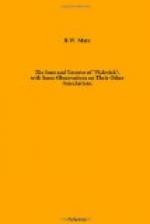Again, in 1584, the inn was described as “Ye Belle Sauvage,” and there have been many speculations as to the origin of the name, and some doubt as to the correct spelling.
In 1648 and 1672 exhibitions of landlords’ tokens of various inns were held, whereat were shown two belonging to “La Belle Sauvage,” the sign of one being that of an Indian woman holding a bow and arrow, and the other, of Queen Anne’s time, that of a savage standing by a bell, and it has been conjectured that this latter sign may have suggested the name. But as the inn was known as “Ye Belle Savage” some sixty years previously this is hardly likely. Another conjecture as to its origin was made by Addison in The Spectator, who, having read an old French romance which gives an account of a beautiful woman called in French “La Belle Sauvage” and translated into English as “Bell Savage,” considered the name was derived from that source. Alderman Sir W. P. Treloar, in his excellent little book on “Ludgate Hill,” puts forth another idea. “As the inn,” he says, “was the mansion of the Savage family, and near to Bailey or Ballium, it is at least conceivable that it would come to be known as the Bail or Bailey Savage Inn, and afterward the Old Bail or Bailey Inn.” We prefer, however, to favour the Isabella Savage theory as the likely one.
Long before Elizabeth’s time and long after-wards the inn was a very famous one. In the days before Shakespeare the actors gave performances of their plays in the old inn yard, using the courtyards as the pit in theatres is used to-day, and the upper and lower galleries for what are now the boxes and galleries of modern theatres. In 1556, the old inns, such as the “Cross Keys,” the “Bull” and “Belle Sauvage” were used extensively for this purpose, the latter, we are told, almost ranking as a permanent theatre. We find Collier also stating that the “Belle Sauvage” was a favourite place for these performances.
Originally the old inn consisted of two courts, an inner and outer one. The present archway from Ludgate Hill led into the latter, which at one time contained private houses. A distinguished resident in one of these (No. 11) was Grinling Gibbons. According to Horace Walpole, Gibbons carved an exquisite pot of flowers in wood, which stood on his window-sill there, and shook surprisingly with the motion of the coaches that passed beneath. The inn proper, surrounded by its picturesque galleries, stood in a corner of the inner court, entered by a second archway about half-way up the yard.
Part of the inn abutted on to the back of Fleet Prison, and Mr. Tearle in his Rambles with an American, bearing this fact in mind, ingeniously suggests that the conception of the idea for smuggling Mr. Pickwick from the prison by means of a piano without works may have been conceived in Mr. Weller’s brain while resting in the “Belle Sauvage” and contemplating the prison wall.




